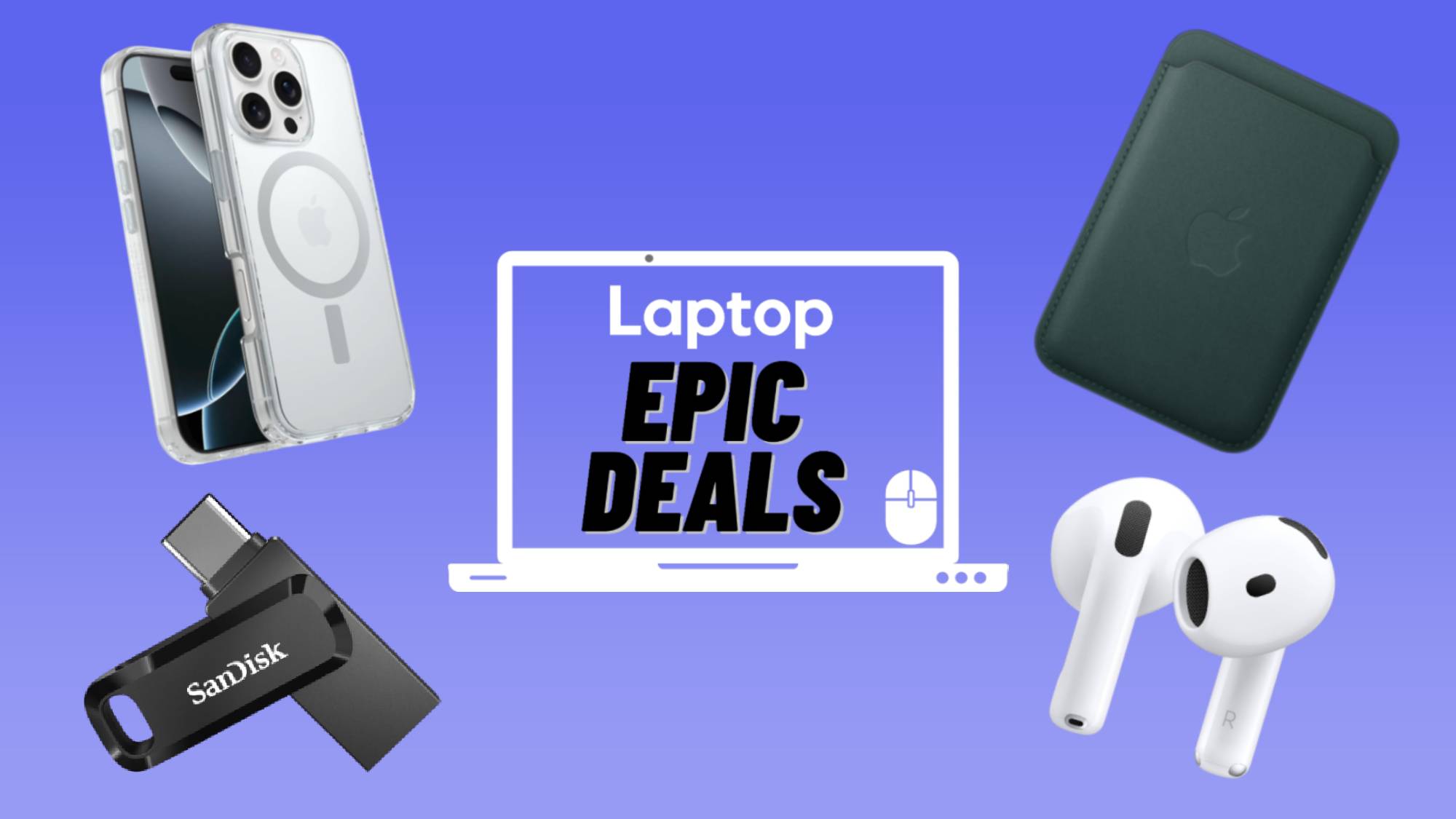Laptop Mag Verdict
The ASUS VivoTab Note 8 stands out in the 8-inch Windows 8 tablet crowd with its built-in stylus. But awkward button placement holds it back.
Pros
- +
Good stylus performance
- +
Useful included-software
- +
Quality speakers
Cons
- -
Poor button location
- -
Heftier than competing slates
- -
Below-average battery life
Why you can trust Laptop Mag
Adding to the growing lineup of 8-inch Windows 8 tablets that offer productivity in a portable package is ASUS' VivoTab Note 8. This small slate distinguishes itself from others with its built-in Wacom stylus, but at $329, it's more expensive than the competition. Is this addition worth the premium?
Design
The words clean, unassuming and professional jump to mind when you look at the ASUS VivoTab Note 8. The all-black tablet is smooth to the touch with a matte plastic back and a glossy face. Unfortunately, both the front and back of the slate are smudge and fingerprint prone.
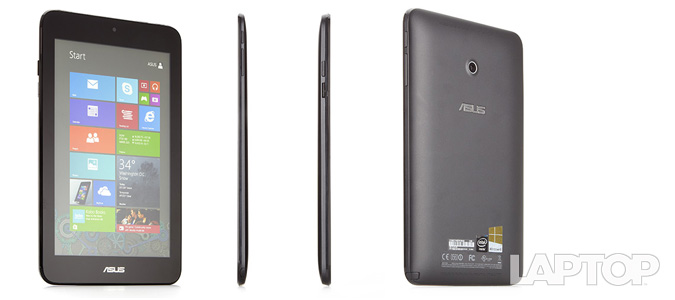
An inch-wide black bezel frames the VivoTab's 8.0-inch display, with a silver ASUS logo below the screen and a 1.2-megapixel camera above it. Adorning the back of the slate is an ASUS logo, which sits below a 5-megapixel camera. At the bottom, lie the device's SonicMaster stereo speakers.

Click to EnlargeA small groove on the bottom left corner of the tablet lets you pry out the Wacom Digitizer stylus with relative ease. However, this accessory is hidden so well along the bottom edge that we almost missed it.
The left side of the VivoTab houses a microSD card reader and a Windows button that is placed in a not very intuitive location. We've seen this same awkward button placement on other 8-inch Windows 8 slates, such as the Dell Venue 8 Pro (top right edge), while the Iconia W4 doesn't even offer a dedicated Windows button. We prefer the Lenovo Miix 2's layout, with the Windows button sitting below the display.
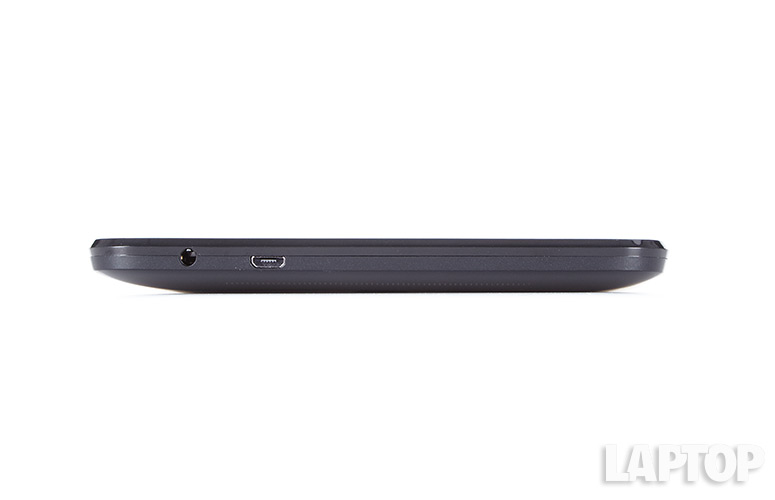
Click to EnlargeAt the top of the VivoTab, are a microUSB port and an audio combo jack, while a power button and volume rocker line the tablet's right side. The buttons are a little stiff and hard to press.
The VivoTab is the largest and almost the heaviest 8-inch Windows 8 tablet on the market, at 8.7 x 5.3 x 0.43 inches and 13.85 ounces. The Lenovo Miix 2 (8.5 x 5.2 x 0.33 inches, 12.2 ounces) and the Dell Venue 8 Pro (8.5 x 5.11 x 0.35 inches, 13.6 ounces) are both lighter and thinner. Acer's Iconia W4 (8.6 x 5.3 x 0.38-0.42 inches, 14.6 ounces) cuts a slightly smaller silhouette, but is heavier.
Stylus Experience
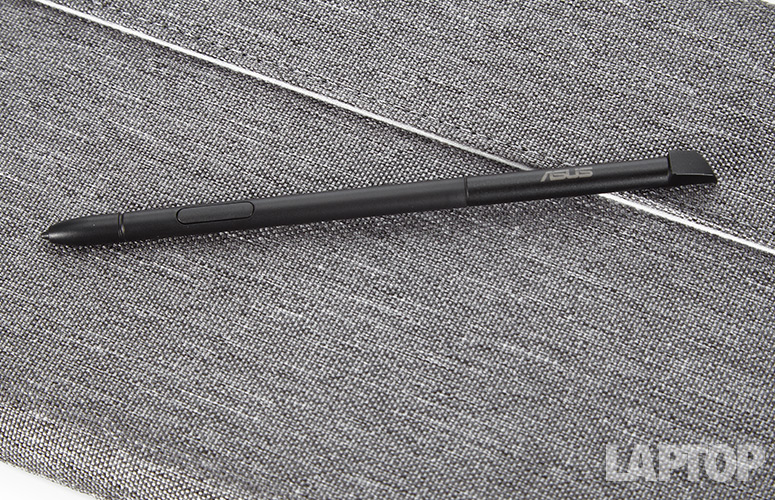
Click to EnlargeASUS' VivoTab Note 8 costs more than the competition because of the included Wacom digitizer. So is it worth it? Boasting 1,024 pressure-sensitivity levels (compared to the 256 or fewer on competing styli), Wacom's pen lets you draw thinner or thicker lines based on how much pressure you apply. Lighter strokes result in thinner lines, while more pressure creates broader strokes. The extra sensitivity-levels create a greater differentiation between those sizes.
Sadly, the only app optimized for the stylus that comes with the VivoTab is Microsoft's OneNote. Strokes were smooth, and the stylus was responsive; we easily autographed the tablet as if writing on paper. You'll find dozens of stylus-centric titles in the Windows Store, including FreshPaint, VirtualTablet, Sketchable, Notable and CyberLink YouNote.
Palm rejection is enabled when the pen is detected. During our testing, this technology worked well most of the time. You can also hover over tiles on your Start screen to get a tip about the app. In pen-optimized apps such as OneNote, hovering will also trigger animations and contextual labels.
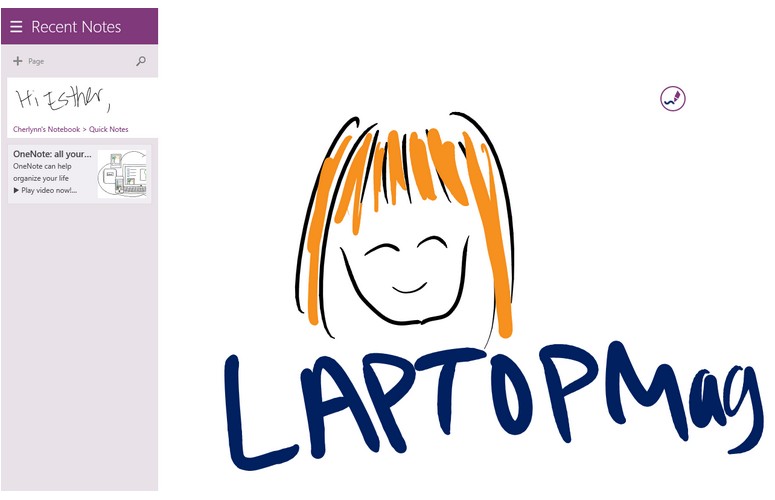
Click to EnlargeA button on the stylus triggers a small, half-inch-wide circle around the cursor. In OneNote, holding this button lets you draw a dotted line around parts of your sketch to select a region, which you can then edit by moving it around, copying and pasting, deleting it, or tagging it with a property. Overall, we prefer Samsung's S Pen for the Galaxy tablets, which provides more functionality.
Display
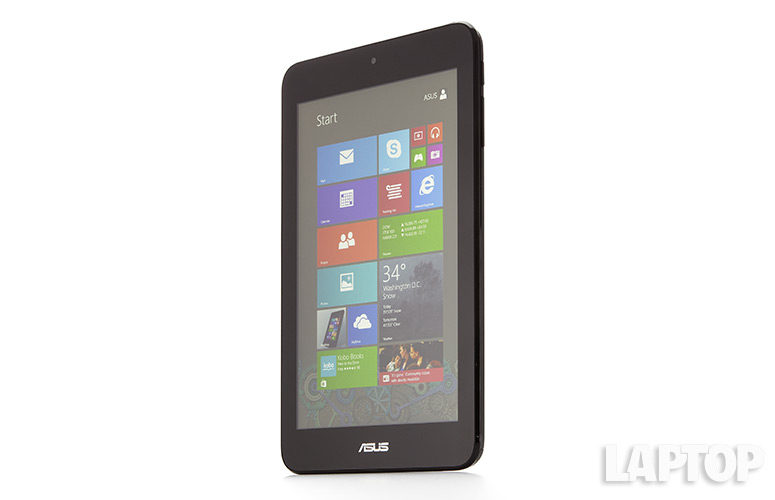
Click to EnlargeImage quality on the VivoTab Note 8's 1280 x 800p IPS, 10-point touch display was vivid but somewhat blurry. In a 1080p trailer for "Maleficent," colors such as the red of Angelina Jolie's luscious lips were vibrant against her alabaster skin, but details such as glowing pixies flying around a little girl were muddy. Words and graphics on such websites as NYtimes.com and Laptopmag.com were crisp, though, and viewing angles were ample, though colors washed out slightly at extreme angles.
The Note 8 could display just 76.6 percent of the sRGB color gamut, which falls below the tablet average of 83 percent, and also trails the Lenovo ThinkPad 8 (84 percent) and the Acer W4 (80 percent). The Note 8's Delta-E rating of 8.5 means its display renders colors less accurately than both the average tablet and the W4 (each rated 6).
Measuring 367 lux on our light meter, the VivoTab outshined the average tablet (362 lux) and the Iconia W4 (343 lux). However, the Venue 8 Pro was brighter (377 lux), and the luminous Miix 2 was in its own league (534 lux).
Audio
We enjoyed the booming audio that filtered through the VivoTab's rear-mounted SonicMaster speaker. Robyn Hurder's voice rang clearly against the distinct drums and brass instruments in "We Go Together" from the musical "Grease," easily filling a small living room. At max volume, notes became somewhat canned, but below 90 percent volume, the music was solid.
Other than SonicMaster enhancements that are built into the speakers, ASUS doesn't offer any software to let you tweak your tablet's sound output.
Notching 74 dB on Laptop Mag's audio test, which involves playing a tone on max and measuring it from 13 inches, the VivoTab Note 8 beat the 72-dB Miix 2 but was softer than the average tablet (79 dB), the Iconia W4 (78 dB) and the Venue 8 Pro (88 dB).
Software and User Interface
The VivoTab Note 8 runs Windows 8.1, the latest iteration of Microsoft's operating system. Improvements include the ability to close Modern apps with a single click, a persistent taskbar in desktop mode, more lock-screen options, and Bing Smart Search that includes both Web and local results.
MORE: Windows 8.1 Update: Full Review
You can configure the lock screen to display a slideshow of your favorite pictures and launch the camera with a swipe down. Notifications from specified apps also appear on the lock page, and you can also answer Skype calls without having to first unlock the device.
When you do unlock it, the device's screen greets you with the colorful Live Tile interface of the Modern UI. Tiles can be rearranged by dragging the stylus, so we had to be careful not to touch the screen and accidentally mess up our layout.
Windows 8.1 brings back what looks like the Start button, but all this button does (after a regular click) is return you to the Live Tiles page. However, long-pressing the Start button brings up a list of options for Task Manager, Control Panel, File Explorer, Programs and Features, and more.
Performance
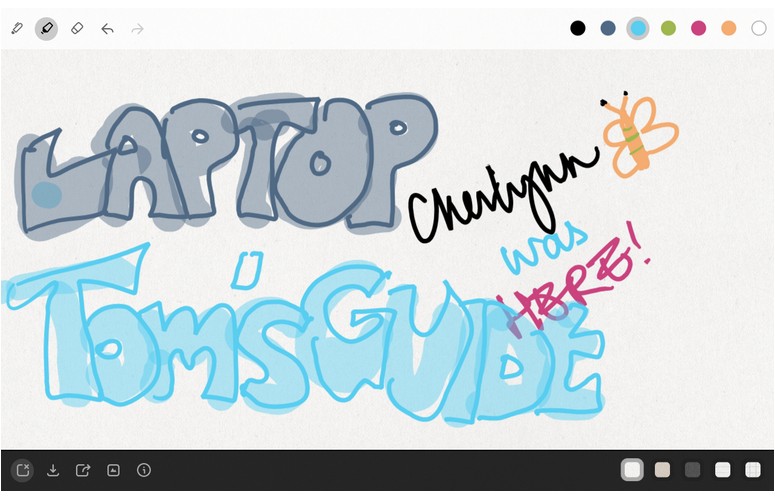
Click to EnlargePowered by a 1.33-GHz quad-core Intel Atom Z3740 chip with 2GB of RAM, the Note 8 delivered so-so performance. We smoothly drew a beautiful watercolor painting on Fresh Paint while apps such as PowerDirector, YouCam and Gallery ran in the background. On the other hand, the camera stuttered between shots, taking a couple of seconds to show a thumbnail of our picture.
The tablet's 32GB eMMC hard drive booted Windows 8 in 13 seconds, faster than the average slate (16 seconds) but slower than the Venue 8 and Iconia W4 (both 10 seconds). The VivoTab's boot time is just shy of the Miix 2 (12 seconds).
On the synthetic test Geekbench 3, the VivoTab scored 2,608 to beat the average tablet (2,044) and the Venue 8 Pro (2,538). It was on a par with the Miix 2 (2,608) and the Iconia W4 (2,630). All systems have the same 1.33-GHz Intel Atom Z3740 CPU with 2GB of RAM.
The VivoTab's PCMark 7 performance was underwhelming. Its score of 2,252 fell short of the average slate (2,862), the Venue 8 Pro (2,263), the Iconia W4 (2,499) and the Miix 2 (2,384).
Taking 21 minutes and 8 seconds to match 20,000 names to their addresses in our OpenOffice spreadsheet test, the VivoTab was slower than the average slate (16:16), the Miix 2 (20:22) and the Venue 8 Pro (20:36). The ASUS was a bit faster than the Iconia W4 (21:34).
With Intel HD Graphics, the VivoTab Note 8 performed well on the 3DMark Ice Storm Extreme graphics test, scoring 9,928 to beat the average slate (6,094), the Venue 8 Pro (8,830), the Iconia W4 (8,910) and the Miix 2 (9,739).
Apps
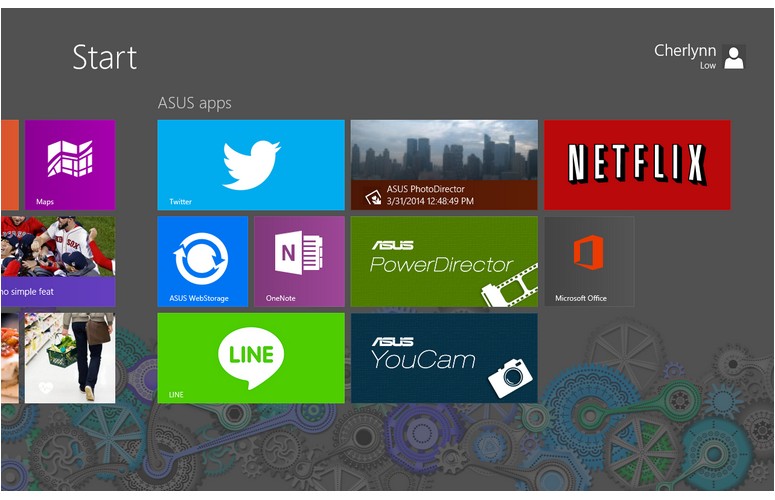
Click to EnlargeIn addition to the standard Windows apps, such as Internet Explorer, Skype, Bing and Xbox Music, ASUS offers a suite of media-editing tools to make your VivoTab Note 8 more useful. These include PowerDirector for editing video, PhotoDirector for your pictures and the YouCam camera app, which offers fun filters and effects.
PhotoDirector provides granular control over your pictures in a user-friendly interface. We easily adjusted brightness, darkness, exposure, contrast, saturation and white-balance levels in our picture of Manhattan's skyline. A Skin tool lets you quickly retouch your portraits, so you can give yourself a digital makeover in seconds. You can also add frames and text bubbles, or create collages with your images on PhotoDirector for virtual scrapbooks.
MORE: Top 25 Windows 8 Apps
PowerDirector lets you turn your videos and photos into movie memories. You can trim your clips, and add effects, background music and titles. PowerDirector also lets you share your masterpieces on Facebook and YouTube.
ASUS additionally bundles the mobile messaging app Line with the VivoTab, so you can easily chat with friends. ASUS includes an activation code for the full Microsoft Home and Office Student 2013 edition (the non-subscription version). Third-party apps include Netflix and Amazon Kindle.
Camera and YouCam App

Click to EnlargeThe Note 8's 5-megapixel rear camera is good in a pinch, but not something you'll want to use to capture important moments. While details, such as edges of buildings, looked clear on our shots of midtown Manhattan's skyline, the warm orange tones of the sunset reflecting off skyscrapers appeared pale. Our 720p video of the view from a 36th-story apartment showed the same clear details but underwhelming color.
The VivoTab's front, 1.2-MP camera took grainy but accurately colored selfies. Our pink-and-blue patchwork shirt looked bright, but the picture showed significant noise.
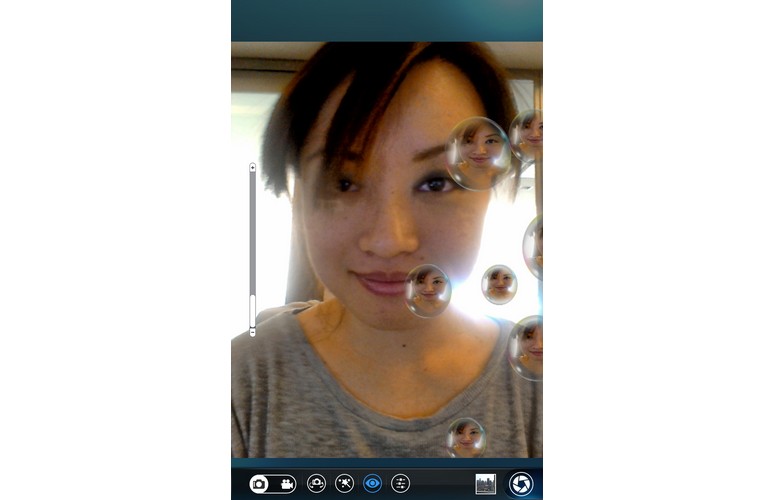
Click to EnlargeIn addition to the built-in Microsoft Camera app, ASUS includes YouCam, which offers several extra features to make your photos and videos pop. The bottom of the viewfinder page hosts a toggle for photo/video, camera change, effects, red eye removal and settings.
Tapping the effects icon displays a submenu that lets you choose from Frames, Particles, Emotions, Draw or Distortion. Particles add a layer of animations or textures to your picture, while Emotions offer comic book-like stamps and animations. With Draw, you can doodle a message on the viewfinder, while distortion lends a funhouse-mirror touch to your images. You can adjust brightness, contrast, exposure, orientation, noise reduction and face tracking under Settings.
We especially enjoyed applying a bubble filter to a selfie and watching as numerous orbs with our face in them floated across the screen.
Battery Life
The VivoTab Note 8 comes with a 3,950-mAh (15-WHr) battery that delivered below-average endurance. On Laptop Mag's battery test, which involves continuous Web surfing over Wi-Fi, the VivoTab lasted 7 hours and 29 minutes. That's a bit less runtime than the average tablet provides (7:47), but significantly behind the Dell Venue 8 (8:18), Acer Iconia W4 (8:25) and Lenvo Miix 2 (8:26).
MORE: 10 Tablets with the Longest Battery Life
Editor's note: We're in the process of normalizing the Laptop Mag battery test for 150 nits of brightness. The Venue 8, Iconia S4 and Miix 2 were benchmarked prior to this change.
Configurations and Accessories
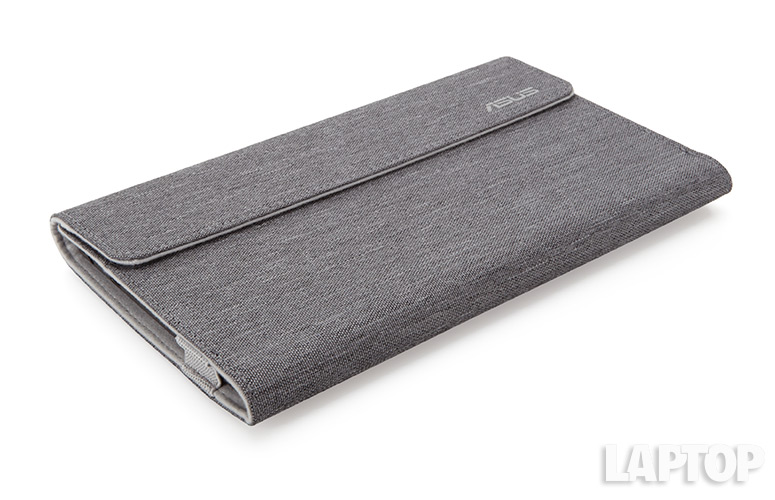
Click to EnlargeOur unit of the VivoTab Note 8 packs 32GB of storage with a 1.33-GHZ quad-core Intel Atom Z3740 CPU and 2GB of RAM, all for $329. ASUS also offers a version with 64GB of storage for $369.
The company sells a $29 VersaSleeve folio that keeps your tablet protected and doubles as a stand. However, it's not the most practical accessory. In order to use it as a stand, you must completely remove the tablet from the sleeve. It also took us quite a bit of finessing to figure out how to use the sleeve in stand form.
Verdict
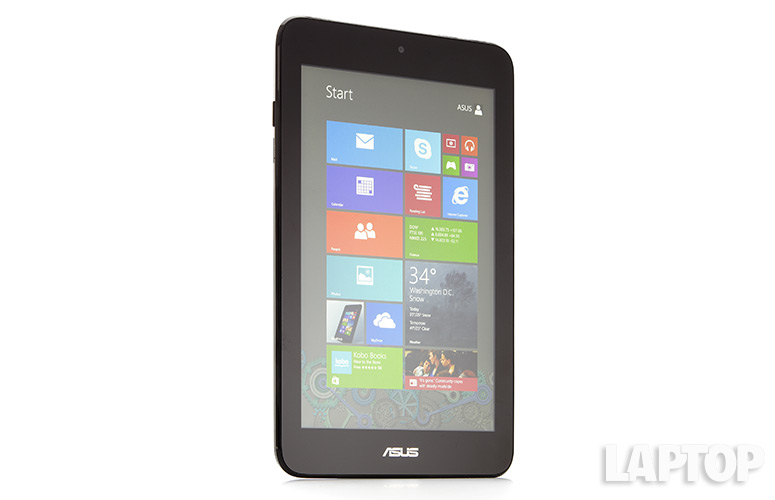
Click to EnlargeDesigned for note taking, the ASUS VivoTab Note 8 delivers a natural, realistic drawing experience with an onboard Wacom stylus that sets it apart from competing Windows 8 slates. The device also comes with an array of fun, useful apps that will boost your creativity. Unfortunately, its below-average battery life and poorly placed Windows button diminish our enthusiasm for this tablet.
If you're looking for a good mix of productivity and portability, Lenovo's Miix 2 is our recommended 8-inch Windows 8 tablet, offering a brighter screen in a sleeker, lighter body, for just $215 on Amazon. But if you want a pen-enabled Windows tablet and can afford the premium, the VivoTab Note 8 delivers.
ASUS VivoTab Note 8 Specs
| Brand | ASUS |
| CPU | 1.33-GHz quad-core Intel Atom BayTrail-T Z3740 |
| Camera Resolution | 5MP |
| Card Reader Size | 64GB |
| Card Readers | microSDXC |
| Company Website | http://www.asus.com/Tablets_Mobile/ASUS_VivoTab_Note_8_M80TA/ |
| Display Resolution | 1280 x 800 |
| Display Size | 8 |
| Front-Facing Camera Resolution | 1.2MP |
| Graphics Chip | Intel HD Graphics |
| Has Bluetooth | Yes |
| OS | Windows 8.1 |
| Ports | Microphone/Headphone, microUSB, microSDXC |
| RAM Included | 2GB |
| Size | 8.66 x 5.26 x 0.43 inches |
| Storage Drive Size | 32GB |
| USB Ports | 1 |
| Warranty / Support | 1-year International Warranty and 1-year accidental damage protection |
| Weight | 13.85 ounces |
| Wi-Fi | 802.11a/b/g/n |

